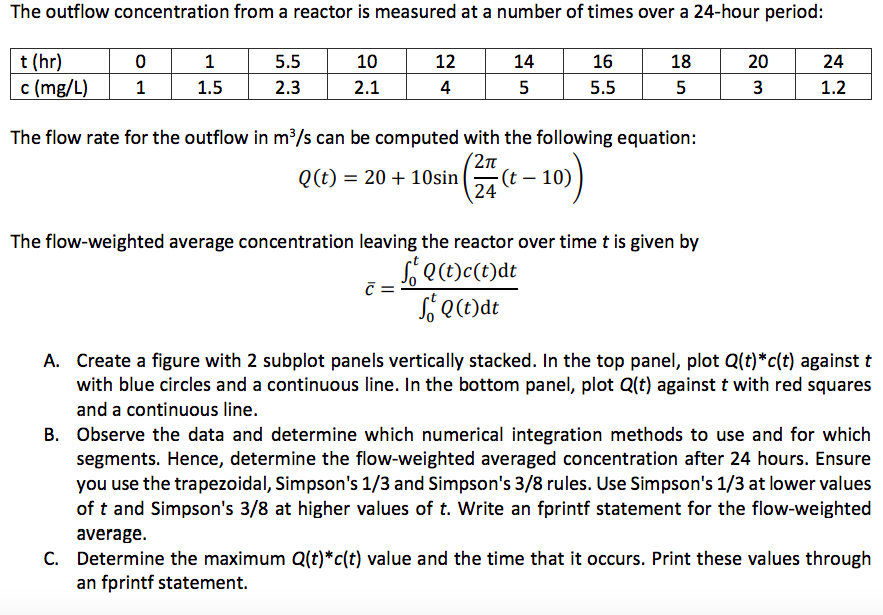
The outflow concentration from a reactor is measured at a number of times over a 24-hour period t (hr) c (mg/L) 11.52.32.1 14 5 16 5.5 18 5 24 1.2 0 1 5.5 10 12 4 20 The flow rate for the outflow in m3/s can be computed with the following equation: 2? 24 Q(t) -2010sin (t- 10) The flow-weighted average concentration leaving the reactor over time t is given by h Q(t)dt A. Create a figure with 2 subplot panels vertically stacked. In the top panel, plot Q(t)*c(t) against t with blue circles and a continuous line. In the bottom panel, plot Q(t) against t with red squares and a continuous line. B. Observe the data and determine which numerical integration methods to use and for which segments. Hence, determine the flow-weighted averaged concentration after 24 hours. Ensure you use the trapezoidal, Simpson's 1/3 and Simpson's 3/8 rules. Use Simpson's 1/3 at lower values of t and Simpson's 3/8 at higher values of t. Write an fprintf statement for the flow-weighted average. C. Determine the maximum Q(t)*c(t) value and the time that it occurs. Print these values through an fprintf statement. The outflow concentration from a reactor is measured at a number of times over a 24-hour period t (hr) c (mg/L) 11.52.32.1 14 5 16 5.5 18 5 24 1.2 0 1 5.5 10 12 4 20 The flow rate for the outflow in m3/s can be computed with the following equation: 2? 24 Q(t) -2010sin (t- 10) The flow-weighted average concentration leaving the reactor over time t is given by h Q(t)dt A. Create a figure with 2 subplot panels vertically stacked. In the top panel, plot Q(t)*c(t) against t with blue circles and a continuous line. In the bottom panel, plot Q(t) against t with red squares and a continuous line. B. Observe the data and determine which numerical integration methods to use and for which segments. Hence, determine the flow-weighted averaged concentration after 24 hours. Ensure you use the trapezoidal, Simpson's 1/3 and Simpson's 3/8 rules. Use Simpson's 1/3 at lower values of t and Simpson's 3/8 at higher values of t. Write an fprintf statement for the flow-weighted average. C. Determine the maximum Q(t)*c(t) value and the time that it occurs. Print these values through an fprintf statement







